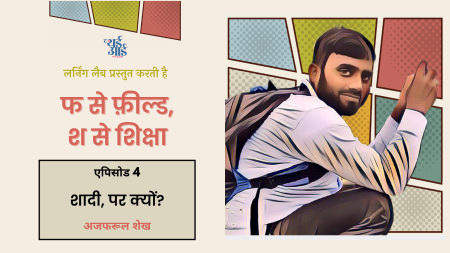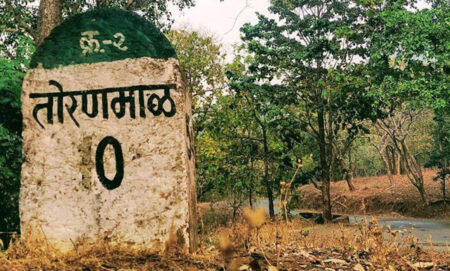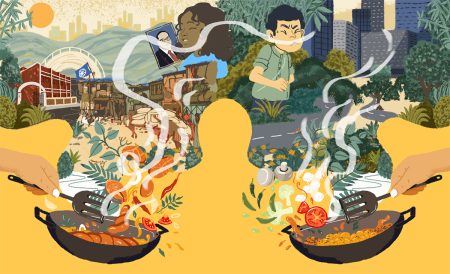With inputs by Juhi Jotwani
“No better way to experience and understand a city than to walk beside someone who is inhabiting it.”
Heritage walks have always been the domain of starry-eyed tourists eager to soak in certain parts of a city in a neatly packaged one-day — nay — a one-hour history lesson. Often, these city walks beckon the privileged, and make the local the subject of marvel and scrutiny. But these women from Welcome Colony have a plan: slicing through the idea of slum walks, turning it inside-out, and skilfully stitching up a walk through their basti that asks a pedagogical question: who lives in your city?
The Urban has always been a primary site for producing and commemorating memories. Feminist cultural geographers have gone one step ahead to ask whose memories become memorialised and whose histories are remembered through urban processes of naming and planning. The girls and women of Shahdara took this thought one step further by asking, “Who is showing what parts of the city to tourists and students?” As informal labour runs through Shahadara’s veins, ‘business’ was chosen as the central theme for the ‘heritage walk’ in the making.
The Welcome Colony trail will undoubtedly traverse the colony’s lanes lined with rooms where pieces of leather are stitched into sandals, and denim transforms into jeans. “The stitching of jeans happens in Welcome and nowhere else in the vicinity,” says Aashiyan proudly. “The cloth is stitched, sent for washing, is finished, packed, and sent to the markets.”
Like many women in resettlement colonies, the northeast Delhi local is the daughter of migrants, and has never been to school. “I used to trim the extra threads of newly-stitched jeans. We would earn Rs.50 for a total of 100 pairs,” she says.

This moment, young girls and women of a resettlement colony are designing a heritage walk for their locality. This enterprise traces its roots to Nirantar’s Parvaaz Adolescents Centre for Education (PACE) programme. PACE — which was developed over six years — addresses the educational needs of adolescent girls and young women in resettlement colonies, who either have dropped out of school or have never enrolled. Aashiyan is an alumnus of this 18-month course and a former mobiliser. The course, in association with the communities the centres operate in, emphasises changing the prevalent narratives about urban resettlement colonies by focusing on girls and women from these colonies.
The PACE curriculum included a series of walks by Darwesh, a Delhi-based startup that took the girls out on thematic walks around Chandni Chowk, Mehrauli, Yamuna and Lodhi Garden (which went online during the pandemic). This is how Aashiyan and her gang got their idea.
Migrant communities in Delhi
Just like how the stories of women fall through the cracks of history textbooks, some areas of Delhi seem to vanish from its postcards.
Prarthana Thakur, Senior Facilitator of Young People’s Education at Nirantar, says, “A large number of migrant communities live in those areas. [They are the] people who build and run this city; those areas are hardly mentioned or brought up when talking about Delhi. Why does this happen?”
So, what is Welcome Colony? “It has 1.5 lakh people, mostly migrants, and around 47,000 houses,” explains 27-year-old Kismat Mansoori, a teacher at PACE and Action India. It is characterised by very narrow lanes crammed with people, dozing dogs and children playing games they just invented.
Large bags of cloth lean against the walls of these houses and groups of women work away inside, sewing buttons on jeans, making colourful bindis and also making shoes. The world of women in this colony rarely expands beyond their worn-out doorstep. Some recall a glimpse of a Delhi outside of these lanes, in rare trips accompanied by relatives. As 22-year-old Shaistha, a learner from the PACE, says, “Till I went on PACE’s historical walks, Delhi was just a name floating in my mind.”
Prarthana, who has spent three years with the girls as an educator, recalls “Many girls who moved to Delhi later in their life mentioned that ‘Delhi’ denotes a lost childhood to them. Because, ever since they came here they did not have the space to play, which they could in the village. For some, ‘Delhi’ means hospitals, as many relatives come to the city for that facility. However, there is also a strong sense of identity among the girls who are raised here from a young age. They identify with the city and hence, restrictions at home trouble them a lot. This creates a permanent conflict between parents and young women.”
Feminist pedagogy
Heritage walks, for many, may be a form of escape from daily life or a history lecture from a god-like narrator. “In contrast, feminist heritage walks aim to locate lost knowledge, reacquaint with legacies of the past, and collaboratively remap the social and intellectual places in which we live or traverse as women in male-dominated heritage landscapes… The fantasy of getting lost, or being invisible, is replaced by a feminist fantasy of finding and being recognised,” argues Australian feminist scholar Alison Bartlett. As a part of feminist pedagogy, Aashiyan and her community’s control over the design and implementation of such a heritage walk transforms the act of walking from sympathetic watching to “empathic witnessing”. In this process, knowledge is not only communicated but also collaboratively produced.
Actor and theatre workshop facilitator Nitika Arora of Darwesh contends that for girls from resettlement colonies and bastis, the city begins at their threshold. “A lot of them said that the only way they find space for themselves is by standing outside their doors, but that too is fraught. They are always asked to go back inside.”
With their walks, Nitika explains, “We are telling the girls the city is yours, you are free to walk the streets.” Through feminist storytelling, hypothetical situations (“… imagine if all the shopkeepers in a market were women …”) and reflective exercises, a unique ‘walk’ emerged that became part of the PACE curriculum.

The night before they head to a ‘water-themed’ walk, there were jitters. Because just as water and electricity do not come easily to bastis, for women like Shaistha, neither does permission to step outside Welcome. “Going out before was difficult. I did not go anywhere with my family as such, except to our relatives’ homes. My family was not willing to send me on these walks. But Didi convinced them,” she says.
With this permission, not to be taken lightly, Shaistha leaves home and joins a group of 30 women to take her first metro ride from Welcome to Mehrauli, 25 kilometres away. Several stops, crossovers and giggly photos later, the group disembarks to Qutub Minar Station and hops into autos to Gate Number 2 of the sprawling Mehrauli Archaeological Parks (MAP). In the backdrop of almost-summery blue skies, the group chatters away, forgetting all the ghoorna (stares).
The girls have baolis (stepwells) to see and stories to hear. In a spot of shade, Yuveka Singh, a member of Darwesh, brings out a coin cut-out. Not just any coin, but one with Razia Sultana’s face on it. “This was one of the first empresses of Delhi who had her name on a coin. She only ruled Delhi for four years, but brought about so many administrative changes, from establishing roadways to reducing tax…” Stories of Roshanara Begum, Mumtaz Mahal, Begum Samru also await.
“It also makes a difference when a woman takes you around and shows you a city, versus a man doing it.
Darwesh has been operated by four women, right from pedagogy to curriculum to execution,” adds Yuveka.
As Ira Mukhoty writes in her book, Heroines: Powerful Indian Women of Myth & History, “The most successful narratives are when women tell the stories of other women using song and verse. It is through the oral medium that the censorship, deliberate and inadvertent, by men in the written medium can be sidestepped.”
The group takes a longer walk to the 15th-century Rajon ki Baoli, leaving the grand ruins of Metcalfe’s summerhouse behind. “Water becomes a pivotal point in discussions of class and caste,” says Yuveka. Around 500 metres away, they make a stop at another baoli, famous for its sulphur and healing properties. Built by Shams ud-Din Iltutmish — the first Muslim sovereign to rule over Delhi — in 1230 CE, the unassuming structure (Gandhaki ki Baoli) reflects the era’s rainwater harvesting techniques, at a time of acute water shortage in Delhi.
Stepwells are often spaces of sisterhood. Several, like Rani ki Baoli and Chandi ki Baoli, were commissioned by women.
Moreover, historically, collecting water from stepwells and other water bodies has been assigned to women of the household. Today, this chore also leads to girls having to drop out of school. “Till two years ago, we also had no taps in Welcome Colony. We used to walk long distances to get water,” says Aashiyan.
The baolis are where the walk concludes and the group heads to the bus stop. But, the stories don’t end here. For the post-session discussion, Yuveka chooses a folk tale of a frog named Tiddalick who drinks up all the water from a fictional pond, leaving nothing for the rest of the animals. “We start the story to discuss what happens when there’s a water crisis. Because the areas the girls come from often undergo water scarcity, while their rich neighbouring districts have an abundance of water, we ask them to discuss the situation through the lens of caste, class, and economics. There are so many Tiddalicks around us.” smiles Yuveka.
As the story goes, the animals make the giant frog laugh and spit out all the water, reviving the dry pond. For the many Tiddalicks of Delhi, there are many women who could fight back — with laughter. Subsequently, several girls in PACE have written letters to their local councillor about the water issues in their homes.
Feminist education
As more refugees across the world started settling in places far away from the homes they were born in, more scholars started studying their home-making practices. One of these practices for the Syrian refugees in Amsterdam is hosting guests. They found that when you host someone in your house, it becomes more of a home.
The civic participation and citizenship of Aashiyan and her community has always been marked by stigma and disenfranchisement. Delhi, like many metropolises of India, has been scarred by a series of evictions of some of its most vulnerable citizens. In a conversation with The Third Eye, Gautam Bhan, faculty member, Indian Institute of Human Settlements, said, “If you’re poor in the city, there is no cultural or economic imagination of where you belong… in the sheher, your mere presence is a question mark.”
The basti either becomes a site of pity or criminality, as we see in eviction after eviction.

This sense of belonging is precious. While it may be discouraged by lack of documentation and civic infrastructure, its claim lies in the personal and intimate knowledge of your own neighbourhood, which is its own kind of history.
At the core of the Nirantar-PACE curriculum, there is a reminder that urges the learners that they do belong to the city and the metropolis depends on them, the migrants. As Purnima, Senior Programme & Pedagogy Specialist, at Nirantar, explains, learners are encouraged to speak and whatever new things come up, there is space to reflect on it. “Conversations should not be shut down. As [Brazilian educator and philosopher] Paulo Friere has said: Reading the word is not only preceded by reading the world, but also by a certain form of writing it or rewriting. I think this is essential, in any teaching-learning process.” The feminist pedagogy in the curriculum entails a new kind of knowledge creation that has openness at its forefront and encourages curiosity to evolve.
Just as Prarthana Thakur of Nirantar says, “These girls going to places in a group; and seeing things and exploring things of their own accord, to have fun, often comes off as strange to people. Sometimes, they stop and ask them also, ‘Where have you all come from? How could this be happening? Girls at leisure in public places is a moment of rebellion.”






